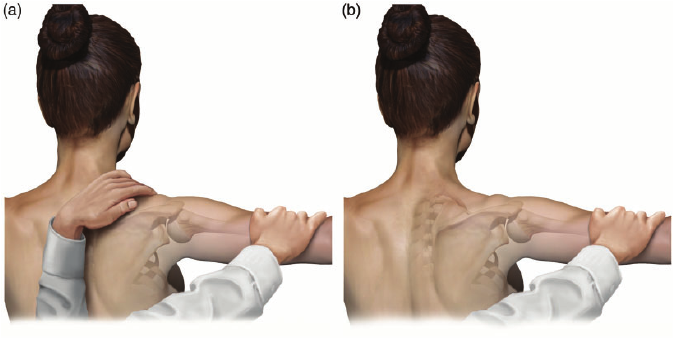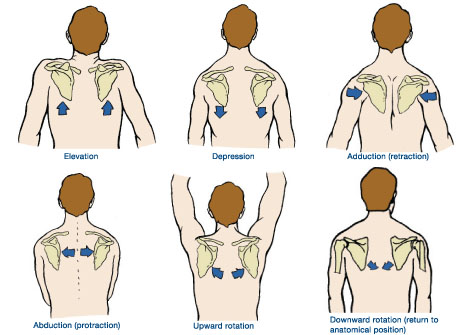The shoulder blades are a highly important part of the human body, as they allow us to perform some of the simplest movements, such as eating, brushing our teeth, and certain sports-related movements. Therefore, if you experience shoulder joint pain or back pain, it might be a good idea to start training the muscles around your shoulders. Scapular retraction and scapular protraction exercises are a great place to start. We recommend speaking with one of our sports medicine professionals for guidance on the correct movements, or to take part in a D1 sports training program.
At SPORT Orthopedics + Physical Therapy, we offer a wide range of treatments for all sorts of sports injuries, chronic pain, and scapular dyskinesis. Training the muscles of the shoulder joint with the help of an experienced physical therapist in Dallas is a simple and effective solution. If you want to eliminate shoulder pain, improve your range of motion, and provide additional support for the spine, contact SPORT today. To schedule an appointment with us, please call 469-200-2832 or fill out our online intake form. Our back specialist in Dallas will help you understand the cause of your pain or stiffness.
What Is Scapular Retraction?
Scapular retractions are those exercises that require you to pull the shoulder blades together toward the spine. However, the shoulders do not move upward toward the ears in these types of exercises. These movements focus specifically on improving the integrity and strength of the muscles around the shoulder blades.
It also aids in the improvement of your posture, which can help with a multitude of problems, such as back pain and shoulder pain. The muscles involved in scapular retraction are the upper trapezius, middle and lower trapezius, rhomboids, and latissimus dorsi.
What Is Scapular Protraction?
Also called abduction of the scapula, this is when the scapulae move laterally away from the spine. It is essentially the opposite of scapular retraction. The muscles involved in shoulder abduction are the serratus anterior, pectoralis major, and pectoralis minor.
Why Is Scapular Retraction Important?
The scapulae, or shoulder blades, are bones rather than muscles. They are surrounded by important muscles in the back which support the upper spine. Although scapular retraction is a small, simple movement, it is an extremely important one. The benefits of these exercises are numerous in that it enhances almost all of the upper back muscles and exercises.
While it does help to strengthen the upper back, it also helps to warm up the muscles in preparation for upper body training. The last benefit, but certainly not the least, is that it aids with connecting your mind and your muscles. It’s important to focus on proper movements in scapular retraction, so we recommend seeing a physical therapist to help ensure that your movements are correct.
Scapular Retraction and Protraction Exercises
Band Scapular Retractions
Scapular retractions involving a resistance band are highly effective as warm-ups that can help you focus before you begin more rigorous exercises. They also help to strengthen your middle and upper back muscles.
- Hold the resistance band in your hands. Raise the arms to about the height of your shoulders.
- Create tension by squeezing your shoulder blades together, but without shrugging them.
- Repeat this in sets of ten repetitions as a part of your warm up.
- If possible, ask someone to film the movements of your back while you do this. This allows you to make improvements on your form in the future.
Hanging Scapular Retractions
These are a bit more challenging than band scapular retractions, as it requires the use of your whole body weight.
- Place the hands onto a pullup bar with your arms out straight.
- This exercise focuses on the upward and downward movements of the scapulars.
- Slowly and carefully go from a full hang position to pulling your scapulars down and together.
- This will activate and engage the middle back muscles. Remember not to shrug your shoulders.
Low Rows
- Sit either on the workout bench or on the floor with your legs out straight. Keep your feet shoulder width apart.
- Grasp onto either the handle or your resistance band.
- Straighten your back and lean back slightly.
- Pull the handle/resistance band toward your lower abdomen, just above the thighs.
- Squeeze the shoulder blades and elbows together to complete the motion.
- Lower the weight to the starting position, then repeat the desired number of reps.
Lateral Pull-Downs
- To minimize movement, position the pad so it lies securely on your thighs.
- Hold the bar with a broad grasp and keep your body erect while gazing forward.
- Slowly pull downward in front of you to your upper torso by retracting your shoulder blades.
- At the bottom of the exercise, squeeze your laterals. Refrain from leaning back to help with the movement.
Reverse Flys
- Begin by standing with feet shoulder width apart. Hold dumbbells of your weight choice at your side.
- In a hinge action, push your hips back, sending your chest forward and virtually parallel to the floor.
- Let the weights hang down while keeping your core strong, back straight, and knees slightly bent.
- Raise your arms out to your sides, keeping a soft bend in the elbows.
- Squeeze the shoulder blades together and pull them toward your spine.
- Lower the weights back to the starting position. Maintain a neutral spine as you complete your repetitions.
Push-Ups
- Place yourself on all four limbs on the floor, with your hands a little wider than your shoulders.
- The elbows should not be locked out. Maintain a tiny bend in them.
- Stretch your legs back until your hands and toes are straight and your feet are hip width apart.
- Raise your belly button towards your spine to tighten your abs and strengthen your core.
- Slowly lower your body to the floor, gradually bending your elbows until they reach a 90-degree angle.
- Push back up through your hands in a controlled manner and return to the beginning position. Repeat the desired number of times.
Dynamic Stretching
Static stretches are not the same as dynamic stretches. Stretches that are dynamic are designed to get the body moving. The stretches aren’t sustained for long periods of time. Lunges with a torso twist are examples of dynamic stretches. Static stretches, on the other hand, include extending and holding muscles for a length of time. The triceps stretch and the butterfly stretch are two examples of static stretches.
Bilateral External Rotation
- Hold both handles of the resistance band in one hand, while holding the middle of the resistance band in the other hand.
- Keep the elbows bent at your sides. Rotate the forearms outward and stretch the band.
- Hold this position for two counts, then slowly return to the original position.
- While you do this, keep the head and chest upright, and the wrists straight.
Standing Rows
- Secure the resistance bands to a door handle or anchor of some kind. This should preferably be at the height of your chest.
- Stand approximately 3 or 4 feet away from the anchor. Position your feet hip width apart, keeping your head up and your chest straight.
- Position the arms out in front of you with the palms facing down.
- Pull your elbows back until they fall even with your shoulders.
Scapular Retraction Test

The scapular retraction test allows a physician to move a patient’s scapula in a way that allows them to examine the integrity of the rotator cuff. Below, we outline the steps of the test.
- The patient begins by sitting on an examination table in an upright position.
- Then, the doctor places their fingertips on the patient’s clavicle while stabilizing the shoulder blade with the palm of their hand.
- The patient then extends the arm to a 90-degree angle on the same side that the doctor is currently examining.
- The doctor pushes down on the extended arm with their free hand.
- If this pressure reduces pain that the patient feels, the test is positive.
If the scapular retraction test improves the strength of the supraspinatus muscle, physical therapy will then focus on improvements to kinetic chain function and improving scapular stability. However, if the strength of that muscle does not improve, then further assessment of the rotator cuff is needed.
What Muscles Are Involved in Scapular Retraction and Protraction?

The scapula is an extremely important bone in the body which allows for multiple types of motion. These types include protraction, retraction, elevation, depression, upward rotation, and downward rotation. This enables us to have a fully functional upper extremity area.
The serratus anterior, pectoralis major, and pectoralis minor muscles are responsible for protraction. The trapezius, rhomboids, and latissimus dorsi muscles are responsible for retraction.
Trapezius, levator scapulae, and rhomboid muscles are responsible for the elevation. Gravity and the activities of the latissimus dorsi, serratus anterior, pectoralis major and minor, and trapezius muscles combine to cause depression.
The trapezius and serratus anterior muscles are responsible for upward rotation. Gravity, and the latissimus dorsi, levator scapulae, rhomboids, and pectoralis major and minor muscles, assist in downward rotation.
Contact SPORT Orthopedics + Physical Therapy Today
At SPORT Orthopedics + Physical Therapy, we understand the importance of healthy shoulder muscle activity. When your shoulders or back are in pain, it’s difficult to complete even the simplest of daily activities. That’s why we’re here to get you back on your feet and back in the game. To speak with a Dallas orthopedic specialist or to schedule physical therapy in Dallas, please contact our office. Call today at 469-200-2832 or fill out our online intake form.



